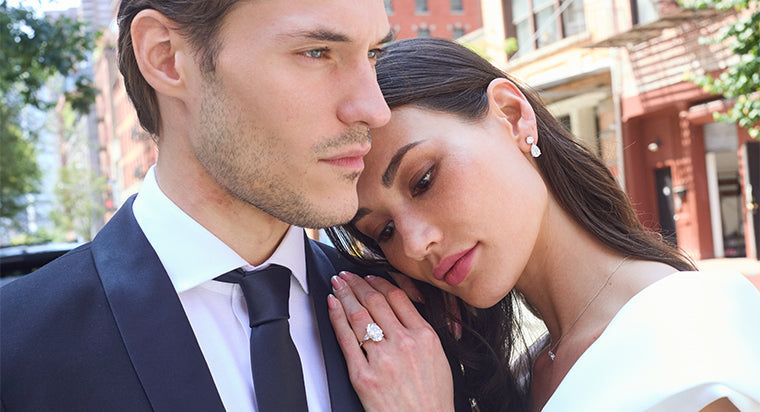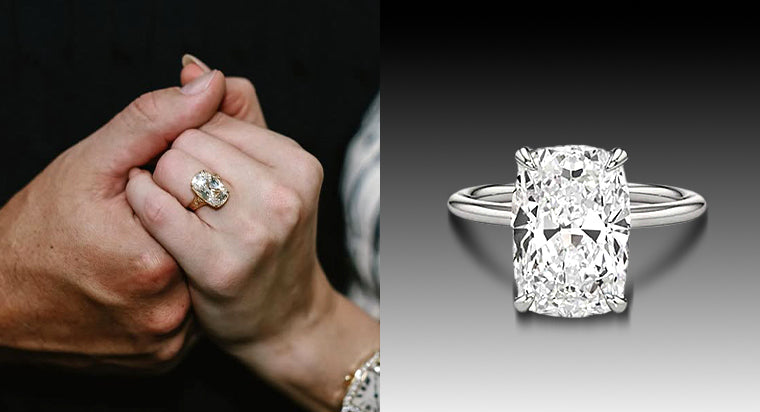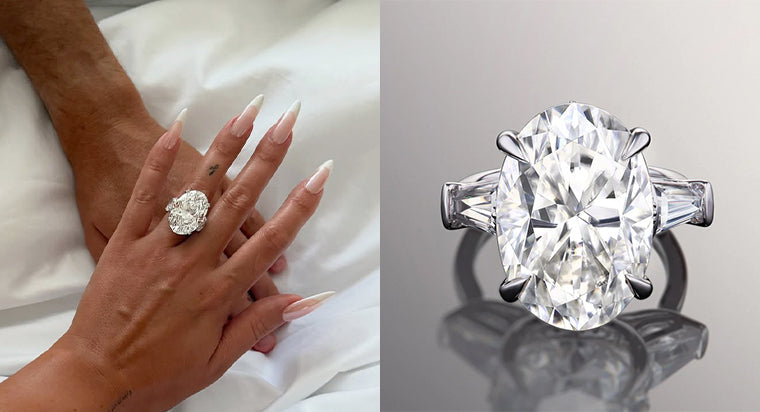Your Complete Guide to Cushion Cut Lab Grown Diamond Engagement Rings

While cushion cut diamonds seem like a newer diamond cut, they're actually more than 200 years old. The cushion cut diamond (once called the old mine cut) looks like a princess cut diamond with rounded corners, much like a pillow cushion and how it got its name. Cushion cut lab grown diamond engagement rings are a favored choice because they have a striking shape and offer plenty of sparkle.
TABLE OF CONTENTS
Introduction to Lab Grown Diamonds
Lab grown diamonds continue to grow in popularity as more consumers are aware of the environmental impacts of diamond mining. You'll find diamonds in all types of cuts, including cushion. Labs recreate the sky-high temperatures and intense pressures in a controlled environment to make lab diamonds. Lab diamonds are "real" diamonds and both are identical optically, chemically, and physically. The only way to distinguish between the two is to look for traces of nitrogen in natural diamonds. Lab diamonds won't have nitrogen.
Advantages of Lab Grown Diamonds
Another reason lab grown diamonds are prevalent is their long list of advantages. You can determine precisely where your lab diamond was made, which means it didn't involve destroying land or ecosystems. Fewer natural resources are required to create diamonds in labs, making lab diamonds sustainable and environmentally friendly. You'll save money because it's less costly to develop lab diamonds. Lab diamonds cost less than natural diamonds so you can get a high-quality diamond at a reasonable price.
Cushion Cut Diamonds
The origin of the cushion cut dates back to the 19th century, when it was called mine cut and eventually the old mine cut. The mine cut was a square diamond with rounded corners but had fewer facets than cushion cuts today. Mine cut was named after Brazilian diamond mines because that's where many stones were mined. Once diamonds were discovered later in South Africa, the Brazilian diamond mines became known as the "old mines." The cut got a new name as well.
Today's cushion cut diamonds have 58 facets, much like round diamonds. The facets provide maximum sparkle from your lab cushion cut. Their unique shape offers a modern, elegant look, and the rounded corners make them even more durable.
Quality Factors
Lab grown cushion cut diamonds are graded on cut, color, clarity, and carat weight - like natural diamonds. The cut is important for cushion diamonds because you want them to be symmetrical and have an excellent length-to-width ratio. You'll see some cushion cuts that are more rectangular and others that are more square. For a more rectangular cushion, look for a diamond between 1.15 and 1.5 times as long as it is wide. The most popular cushion shape is a slight rectangle with a length between 1.10 to 1.20 times the width.
Design Options
The cushion cut is versatile and looks amazing in different engagement ring styles. Look at different settings to see what style you like the most. Popular styles include solitaires, three-stone rings, pave bands, vintage, halos, and rings with secret details like hidden halos. Once you've found the setting you like, you can select the center stone based on your budget and your quality preferences. You'll have thousands of cushion lab grown diamonds to choose from - each diamond is unique, so sift through each option. You'll also need to select the metal for your setting. Most engagement rings are made from platinum or gold (white, yellow, or rose).
Certification and Authentication
You'll spend time carefully selecting the center cushion stone in your engagement ring, and you want to ensure that the diamond you get matches the diamond you picked out. You also want to make sure the diamond is authentic. One way to ease your mind is to get certified diamonds. The accompanying GIA or IGI report provides details about your diamond and proves that it's authentic.
Care and Maintenance
Your ring will last for years if you take the time to care for and maintain it. You can easily clean your ring at home by soaking your cushion cut lab grown engagement ring in a bowl of warm, soapy water. Soak it for 15-20 minutes, then use a gentle brush to scrub the setting and around your diamonds. You'll also want a professional jeweler to look at your engagement ring about once a year. They will examine your ring under a microscope to examine the stones to ensure they're not loose.
They'll also check the prongs to make sure they're not worn down, broken, or missing. Those tiny prongs help keep all of your gorgeous diamonds safe and secure! Leaving your engagement ring at home is also a good idea if you're exercising, swimming, cleaning, gardening, etc. Losing or damaging your ring would be awful!
Conclusion
While cushion cut diamonds seem newer, they're actually a cut that was everywhere hundreds of years ago. Technological advances have perfected the cushion cut diamond over the past 200 years, so today's cushion cut lab diamond emits tons of sparkle from its 58 facets. Cushion cut diamonds are versatile and attractive in various settings, from classic solitaires to halo settings. Find a setting that matches your style, select a stunning lab grown diamond, and then pick a metal that reflects your preferences. You can easily create a gorgeous ring that feels like it represents you.









